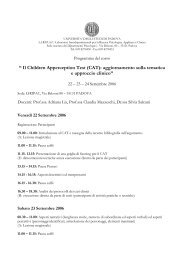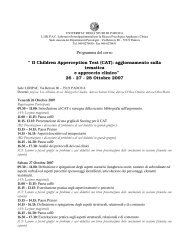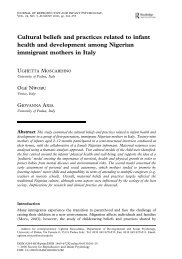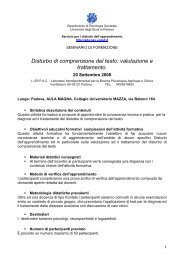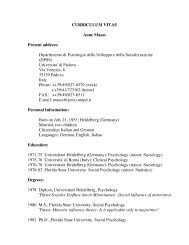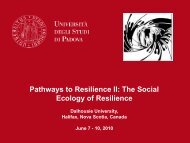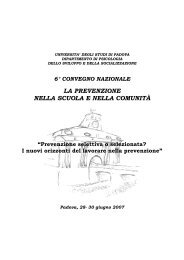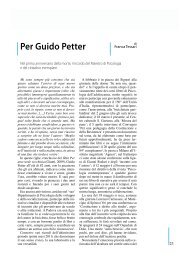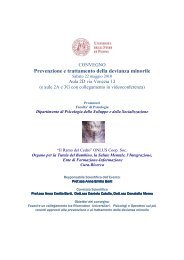Social cognition and moral cognition in bullying: What's ... - DPSS
Social cognition and moral cognition in bullying: What's ... - DPSS
Social cognition and moral cognition in bullying: What's ... - DPSS
You also want an ePaper? Increase the reach of your titles
YUMPU automatically turns print PDFs into web optimized ePapers that Google loves.
Quite recently, the “traditional” classification of schoolchildren <strong>in</strong>to bullies,<br />
victims <strong>and</strong> controls has been criticized <strong>and</strong> several authors stressed the importance of<br />
consider<strong>in</strong>g bully<strong>in</strong>g a group process (Sutton & Smith, 1999). The empirical<br />
confirmation of the importance of peer ecology applied to bully<strong>in</strong>g phenomenon derives<br />
from several observational studies carried out dur<strong>in</strong>g periods of free <strong>in</strong>teraction among<br />
children <strong>in</strong> unstructured contexts, such as dur<strong>in</strong>g recess <strong>and</strong> outdoor play. These studies,<br />
<strong>in</strong> fact, consistently found that peers are <strong>in</strong>volved <strong>in</strong> 85% of bully<strong>in</strong>g episodes (Atlas &<br />
Pepler, 1998; Craig & Pepler, 1997; Craig, Pepler, & Atlas, 2000; Pepler & Craig,<br />
1995). Moreover, Salmivalli, Lagerspetz, Björkqvist, Österman, <strong>and</strong> Kaukia<strong>in</strong>en (1996)<br />
identified six different participant roles taken by <strong>in</strong>dividual children <strong>in</strong> the bully<strong>in</strong>g<br />
process (i.e. victim, bully, re<strong>in</strong>forcer of the bully, assistant to the bully, defender of the<br />
victim, <strong>and</strong> outsider). Another study by Salmivalli, Huttunen, <strong>and</strong> Lagerspetz (1997) has<br />
also revealed a strong <strong>in</strong>fluence of how the members of a group behave <strong>in</strong> bully<strong>in</strong>g<br />
situations on an <strong>in</strong>dividual child’s behavior <strong>in</strong> such situations.<br />
In l<strong>in</strong>e with this approach that considers bully<strong>in</strong>g as a group phenomenon, all<br />
dist<strong>in</strong>ct roles with<strong>in</strong> the class were considered <strong>in</strong> the present study. Not only bullies <strong>and</strong><br />
victims participated, but also those pupils who, <strong>in</strong> different ways, act important roles <strong>in</strong><br />
re<strong>in</strong>forc<strong>in</strong>g bully<strong>in</strong>g behavior (the so-called “Followers”: the Assistants of the bully <strong>and</strong><br />
the Re<strong>in</strong>forcers) or, <strong>in</strong> contrast, <strong>in</strong>tervene to defend the victim (the Defenders). F<strong>in</strong>ally,<br />
Outsiders, that is children not directly <strong>in</strong>volved <strong>in</strong> the phenomenon, were considered.<br />
9



